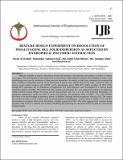Mixture design experiment on dissolution of pioglitazone hcl solid dispersion as affected by hydrophilic polymers interaction
Date
2016Author
Rashid, Harun Ar
Faisal, Khandokar Sadique
Bhyian, Md. Habib Ullah
Alam, Md. Jahangir
Hasan, Md.Mehdi
Metadata
Show full item recordAbstract
Methods available to improve dissolution include salt formation, micronization and addition of solvent or surface active agents. The development of solid dispersions as a practically viable method to enhance bioavailability of poorly water soluble drugs overcame the limitations of those previous approaches. No studies, to date, have systematically examined the effect of different hydrophilic polymer on the dissolution of poorly water soluble drug. In this study, interaction effect of propyl methyl cellulose cp15 (HPMC cp15), polyethylene glycol 6000 (PEG 6000), povidone 30 (PVP K30), eudragit EPO, polaxamer 407 on dissolution of pioglitazone HCl solid dispersion were investigated by a mixture design experiment. Blends of HPMC, PEG 6000, PVP K30, eudragit and polaxamer 407 were prepared according to an augmented simplex-centroid mixture design (10 points) and the drug polymer ratio was 1:3 in the solid dispersion formulation. An appropriate mathematical model was fitted to express the response. The synergistic effect of HPMC : PG : POLOXMER, had shown to be much stronger in quaternary blends. In addition, Eudragit showed an tagonistic effect (p<.05). The contour plot reveled the effects of the tertiary bends on the dissolution of pioglitazone. Tertiary blend of HPMC, PVP and PEG demonstrated a synergistic effect on the dissolution, at higher proportion of PEG. This study suggested that a mixture design approach could serve as a valuable tool in better elucidating and predicting the interaction effects beyond the conventional polymers blends.

